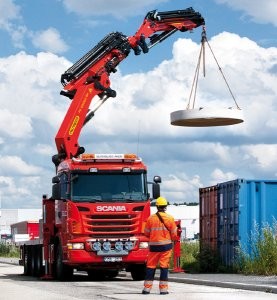
PALFINGER’s product developers have always had a special affinity for practical and particularly user-friendly solutions and they have demonstrated this over and over. Once again, their latest development in stability control is setting new standards. We are talking here about “HPSC”. HP stands for High Performance. SC stands for Stability Control. What this really means is another intelligent PALFINGER system that increases comfort and safety when operating truck-mounted cranes.
During the development and introduction of PALFINGER’s new High Performance crane generation, which clearly focused on optimizing customer benefit, it was only logical to develop the 3-stage ISC system into a flexible “HPSC” stability control system. HP as an abbreviation for High Performance encompasses superiority in efficiency, operating comfort and safety. This is a proportional system which recalculates and defines the permissible working range for any stabilizer situation. Sensors for proportional path measurement located in the stabilizers make their positioning fully variable.
The HPSC system calculates and defines the permissible working range from 0 to 360° for any stabilizer situation. It works more efficiently than comparable systems available in the market thanks to software developed in the company’s own electronics department which is based on an intelligent algorithm.
The algorithm developed by PALFINGER is a complex calculation process which enables a very accurate approximation to the vehicle’s actual stability based on the crane and vehicle’s real data. The accuracy is achieved by also including data such as the vehicle’s torsion in the calculation and determining an inherent value for stability every 1.4° degrees. This maximum approximation to the vehicle’s physical tipping limit makes it possible to exploit the crane’s safe working range to its fullest extent.
PALFINGER’s new integrated stability control helps the crane operator to achieve maximum comfort and safety during crane operations even where space is restricted. It is often the case in densely built-up areas, in flowing traffic or similar situations that the vehicle can only be supported on one side or it may only be possible to support it partially and sometimes not at all. In the HPSC PALFINGER has developed a system defined by maximum flexibility and user-friendliness and has brought it to series maturity following a series of successfully completed field tests with the result that that working with the crane is safe even in cases such as these.
The HPSC system incorporates the current stability support situation including additional stabilizers into the crane’s electronic safety system. It adjusts the crane’s lifting power depending on the current stability support situation and the position of the crane boom to ensure the vehicle’s stability over the entire working range. The operator can read off the current status at any time on the clearly laid out display on the operator’s console or on the display of the radio remote control.
The position of the stabilizer is recorded by means of cable extension transducers or magnetostrictive position sensors in the stabilizer support. The entire sensor system is mounted inside the unit to conform with PALFINGER’s functional design language and is therefore protected against damage, dirt and the elements.
When the crane is handed over, the HPSC system is set up on site using the in-house PALDIAG software adjusted specifically to the vehicle body. Integration into the CAN bus of the overall system means that diagnostics can be run by connecting directly to PALFINGER’s diagnostic software. As a result, it is a breeze for PALFINGER’s global service team to set the perfect parameters for each customer’s controller and to carry out a diagnostic if servicing is required.



